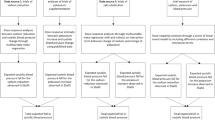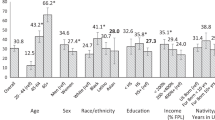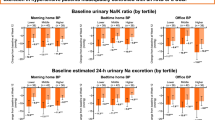Abstract
The mechanisms underlying the adverse cardiovascular effects of increased salt intake are incompletely understood, but parallel increases in serum sodium concentration may be of importance. The aim of this retrospective cohort study was to investigate the relationship between serum sodium, hypertension and incident cardiovascular disease (CVD). Routinely collected primary care data from the Royal College of General Practitioners Research and Surveillance Centre were analysed. A total of 231,545 individuals with a measurement of serum sodium concentration at baseline were included. Exclusion criteria were: age < 40 years; abnormal serum sodium; diabetes mellitus; prior CVD event; stage 5 chronic kidney disease; and liver cirrhosis. The primary outcome was incident CVD (myocardial infarction, acute coronary syndrome, coronary revascularisation, stroke, transient ischaemic attack or new heart failure diagnosis) over 5 years. There was a ‘J-shaped’ relationship between serum sodium concentration and primary cardiovascular events that was independent of established risk factors, medications and other serum electrolytes. The lowest cardiovascular risk was found with a serum sodium between 141 and 143 mmol/l. Higher serum sodium was associated with increased risk in hypertensive individuals, whereas lower concentrations were associated with increased risk in all individuals. Therefore, alterations in serum sodium concentration may be a useful indicator of CVD risk. Higher serum sodium could have a direct effect on the vasculature, particularly in hypertensive individuals. Lower serum sodium may be a reflection of complex volume and neuroendocrine changes.
This is a preview of subscription content, access via your institution
Access options
Subscribe to this journal
Receive 12 digital issues and online access to articles
$119.00 per year
only $9.92 per issue
Buy this article
- Purchase on Springer Link
- Instant access to full article PDF
Prices may be subject to local taxes which are calculated during checkout



Similar content being viewed by others
References
He FJ, MacGregor GA. Salt reduction lowers cardiovascular risk: meta-analysis of outcome trials. Lancet. 2011;378:380–2.
He FJ, Li J, Macgregor GA. Effect of longer term modest salt reduction on blood pressure: Cochrane systematic review and meta-analysis of randomised trials. BMJ. 2013;346:f1325.
He FJ, Markandu ND, Sagnella GA, de Wardener HE, MacGregor GA. Plasma sodium: ignored and underestimated. Hypertension. 2005;45:98–102.
de Wardener HE, He FJ, MacGregor GA. Plasma sodium and hypertension. Kidney Int. 2004;66:2454–66.
Suckling RJ, He FJ, Markandu ND, MacGregor GA. Dietary salt influences postprandial plasma sodium concentration and systolic blood pressure. Kidney Int. 2012;81:407–11.
Bulpitt CJ, Shipley MJ, Semmence A. Blood pressure and plasma sodium and potassium. Clin Sci (Lond). 1981;61(suppl 7):85s–7s.
Komiya I, Yamada T, Takasu N, Asawa T, Akamine H, Yagi N, et al. An abnormal sodium metabolism in Japanese patients with essential hypertension, judged by serum sodium distribution, renal function and the renin-aldosterone system. J Hypertens. 1997;15:65–72.
He FJ, Fan S, MacGregor GA, Yaqoob MM. Plasma sodium and blood pressure in individuals on haemodialysis. J Hum Hypertens. 2013;27:85–9.
Norman RA Jr., Coleman TG, Wiley TL Jr., Manning RD Jr., Guyton AC. Separate roles of sodium ion concentration and fluid volumes in salt-loading hypertension in sheep. Am J Physiol. 1975;229:1068–72.
Friedman SM, McIndoe RA, Tanaka M. The relation of blood sodium concentration to blood pressure in the rat. J Hypertens. 1990;8:61–6.
Suckling RJ, Swift PA, He FJ, Markandu ND, MacGregor GA. Altering plasma sodium concentration rapidly changes blood pressure during haemodialysis. Nephrol Dial Transplant. 2013;28:2181–6.
Oberleithner H, Riethmuller C, Schillers H, MacGregor GA, de Wardener HE, Hausberg M. Plasma sodium stiffens vascular endothelium and reduces nitric oxide release. Proc Natl Acad Sci USA. 2007;104:16281–86.
Gu JW, Anand V, Shek EW, Moore MC, Brady AL, Kelly WC, et al. Sodium induces hypertrophy of cultured myocardial myoblasts and vascular smooth muscle cells. Hypertension. 1998;31:1083–87.
Gheorghiade M, Abraham WT, Albert NM, Gattis Stough W, Greenberg BH, O’Connor CM, et al. Relationship between admission serum sodium concentration and clinical outcomes in patients hospitalized for heart failure: an analysis from the OPTIMIZE-HF registry. Eur Heart J. 2007;28:980–8.
Rusinaru D, Tribouilloy C, Berry C, Richards AM, Whalley GA, Earle N, et al. Relationship of serum sodium concentration to mortality in a wide spectrum of heart failure patients with preserved and with reduced ejection fraction: an individual patient data meta-analysis(dagger): meta-analysis global group in chronic heart failure (MAGGIC). Eur J Heart Fail. 2012;14:1139–46.
Goldberg A, Hammerman H, Petcherski S, Zdorovyak A, Yalonetsky S, Kapeliovich M, et al. Prognostic importance of hyponatremia in acute ST-elevation myocardial infarction. Am J Med. 2004;117:242–8.
Rodrigues B, Staff I, Fortunato G, McCullough LD. Hyponatremia in the prognosis of acute ischemic stroke. J Stroke Cerebrovasc Dis. 2014;23:850–4.
Dmitrieva NI, Burg MB. Elevated sodium and dehydration stimulate inflammatory signaling in endothelial cells and promote atherosclerosis. PLoS ONE. 2015;10:e0128870.
Wang AYM, Lu Y, Cheung S, Chan IHS, Lam CWK. Plasma sodium and subclinical left atrial enlargement in chronic kidney disease. Nephrol Dial Transplant. 2013;28:2319–28.
Wannamethee SG, Shaper AG, Lennon L, Papacosta O, Whincup P. Mild hyponatremia, hypernatremia and incident cardiovascular disease and mortality in older men: a population-based cohort study. Nutr Metab Cardiovasc Dis. 2016;26:12–9.
Hippisley-Cox J, Coupland C, Vinogradova Y, Robson J, Minhas R, Sheikh A, et al. Predicting cardiovascular risk in England and Wales: prospective derivation and validation of QRISK2. BMJ . 2008;336:1475.
Department for Communities and Local Government. English indices of deprivation. https://www.gov.uk/government/collections/english-indices-of-deprivation. Accessed 19 Sept 2018.
Levey AS, Stevens LA, Schmid CH, Zhang YL, Castro AF 3rd, et al. A new equation to estimate glomerular filtration rate. Ann Intern Med. 2009;150:604–12.
Harrell Jr FE. Regression modelling strategies with applications to linear models, logistic regression, and survival analysis. 1st ed. New York: Springer-Verlag Publishers; 2001.
Zhang Z, Duckart J, Slatore CG, Fu Y, Petrik AF, Thorp ML, et al. Individuality of the plasma sodium concentration. Am J Physiol Ren Physiol. 2014;306:F1534–43.
Gao S, Xiangqin C, Wang X, Burg MB, Dmitrieva NI. Cross-sectional positive association of serum lipids and blood pressure with serum sodium within the normal reference range of 135-145 mmol/L. Arterioscler Thromb Vasc Biol. 2017;37:598–606.
Millett C, Laverty AA, Stylianou N, Bibbins-Domingo K, Pape UJ. Impacts of a national strategy to reduce population salt intake in England: serial cross sectional study. PLoS ONE. 2012;7:e29836.
Public Health England. National Diet and Nutrition Survey: assessment of dietary sodium. Adults (19 to 64 years) in England, 2014. https://www.gov.uk/government/statistics/national-diet-and-nutrition-survey-assessment-of-dietary-sodium-in-adults-in-england-2014. Accessed 19 Sept 2018.
Alsanjari ON, de Lusignan S, van Vlymen J, Gallagher H, Millett C, Harris J, et al. Trends and transient change in end-digit preference in blood pressure recording: studies of sequential and longitudinal collected primary care data. Int J Clin Pract. 2012;66:37–43.
Dmitrieva NI, Burg MB. Secretion of von Willebrand factor by endothelial cells links sodium to hypercoagulability and thrombosis. Proc Natl Acad Sci USA. 2014;111:6485–90.
Wild J, Soehnlein O, Dietel B, Urschel K, Garlichs CD, Cicha I. Rubbing salt into wounded endothelium: sodium potentiates proatherogenic effects of TNF-alpha under non-uniform shear stress. Thromb Haemost. 2014;112:183–195.
Lilly LS, Dzau VJ, Williams GH, Rydstedt L, Hollenberg NK. Hyponatremia in congestive heart failure: implications for neurohumoral activation and responses to orthostasis. J Clin Endocrinol Metab. 1984;59:924–30.
Lee WH, Packer M. Prognostic importance of serum sodium concentration and its modification by converting-enzyme inhibition in patients with severe chronic heart failure. Circulation . 1986;73:257–67.
O’Donnell M, Mente A, Rangarajan S, McQueen MJ, Wang X, Liu L, et al. Urinary sodium and potassium excretion, mortality, and cardiovascular events. N Engl J Med. 2014;371:612–23.
De Bacquer D, De Backer G, De Buyzere M, Kornitzer M. Is low serum chloride level a risk factor for cardiovascular mortality? J Cardiovasc Risk. 1998;5:177–84.
Acknowledgements
Patients and practices of the RCGP Research and Surveillance Centre who allow their data to be used for surveillance and research; EMIS, InPractice Computer Systems, TPP SystmOne and other computerised medical record system vendors; Apollo Medical Systems who facilitate data extraction; and Barbara Arrowsmith, SQL Developer, for support with data extraction.
Author information
Authors and Affiliations
Corresponding author
Ethics declarations
Conflict of interest
FJH is a member of Consensus Action on Salt & Health (CASH) and World Action on Salt & Health (WASH). Both CASH and WASH are non-profit charitable organisations and FJH does not receive any financial support from CASH or WASH. GAM is Chairman of Blood Pressure UK (BPUK), Chairman of CASH, WASH and Action on Sugar (AoS). BPUK, CASH, WASH and AoS are non-profit charitable organisations. GAM does not receive any financial support from any of these organisations. SdeL is Director of the RCGP RSC. The remaining authors declare that they have no conflict of interest.
Electronic supplementary material
Rights and permissions
About this article
Cite this article
Cole, N.I., Suckling, R.J., Swift, P.A. et al. The association between serum sodium concentration, hypertension and primary cardiovascular events: a retrospective cohort study. J Hum Hypertens 33, 69–77 (2019). https://doi.org/10.1038/s41371-018-0115-5
Received:
Revised:
Accepted:
Published:
Issue Date:
DOI: https://doi.org/10.1038/s41371-018-0115-5
This article is cited by
-
Age-dependent sex differences in cardiometabolic risk factors
Nature Cardiovascular Research (2022)



